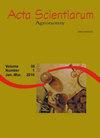结合直立植株和籽粒缓慢变黑的carioca普通豆系选择的替代方案
IF 1.2
4区 农林科学
Q3 AGRONOMY
引用次数: 0
摘要
在巴西,对普通豆(Phaseolus vulgaris L.)品种的需求不断增加,这些品种具有carioca型(奶油色的种皮带有棕色条纹)豆类,其颜色较浅,持续时间较长,并且最可能是直立的植物结构。然而,植物育种家发现很难在同一品种中结合这两种性状。本研究的目的是比较将这两种性状组合在一起的普通豆新品系中,分别从亲本中分离25%、50%或75%的等位基因,在直立植株结构和持久浅色豆籽粒中进行对比,从而获得选育成功的结果。用浅色豆类亲本(P1)和直立植株亲本(P2)进行双亲本杂交。从F1种子中获得3个群体,等位基因频率分别为P1的75%、50%和25%。随后,在F2:3、F2:4、F2:5和F2:6代中对每个种群的后代进行了相似数量的评估。采用评分量表对植株构型(PA)和籽粒暗化(GD)性状进行视觉评价。估计了所有世代的遗传和表型参数。使用有利于直立植株结构或籽粒变暗较慢的亲本等位基因比例较高的群体,无论是在变异的释放方面,还是在两种性状表型有利的后代的出现方面,都没有表现优势。本文章由计算机程序翻译,如有差异,请以英文原文为准。
Alternatives for selection of carioca common bean lines that combine upright plants and slow grain darkening
In Brazil, there is an increasing demand for common bean (Phaseolus vulgaris L.) cultivars having Carioca-type (cream-colored seed coat with brown stripes) beans which have a light color that persists for a longer time combined with the most possible upright plant architecture. However, plant breeders are finding it difficult to combine these two traits in the same cultivar. The aim of this study was to compare success in the selection of new common bean lines that combine the two traits in segregating populations with 25%, 50%, or 75% of the alleles from the parents contrasting in upright plant architecture or in bean grains with persistent light color. A biparental cross was performed between a parent with light-colored beans (P1) and another with upright plants (P2). Three populations were obtained from the F1 seeds, with allelic frequencies of 75%, 50%, and 25% of P1. Subsequently, progenies were evaluated in a similar number in each population in the F2:3, F2:4, F2:5, and F2:6 generations. The plant architecture (PA) and grain darkening (GD) traits were visually evaluated using a scoring scale. Genetic and phenotypic parameters were estimated for all generations. There was no expressive advantage in using populations with a greater allele proportion of the parent favorable to upright plant architecture or slow grain darkening either in releasing of variability or in the occurrence of progenies with favorable phenotypes for the two traits.
求助全文
通过发布文献求助,成功后即可免费获取论文全文。
去求助
来源期刊

Acta Scientiarum. Agronomy.
Agricultural and Biological Sciences-Agronomy and Crop Science
CiteScore
2.40
自引率
0.00%
发文量
45
审稿时长
>12 weeks
期刊介绍:
The journal publishes original articles in all areas of Agronomy, including soil sciences, agricultural entomology, soil fertility and manuring, soil physics, physiology of cultivated plants, phytopathology, phyto-health, phytotechny, genesis, morphology and soil classification, management and conservation of soil, integrated management of plant pests, vegetal improvement, agricultural microbiology, agricultural parasitology, production and processing of seeds.
 求助内容:
求助内容: 应助结果提醒方式:
应助结果提醒方式:


